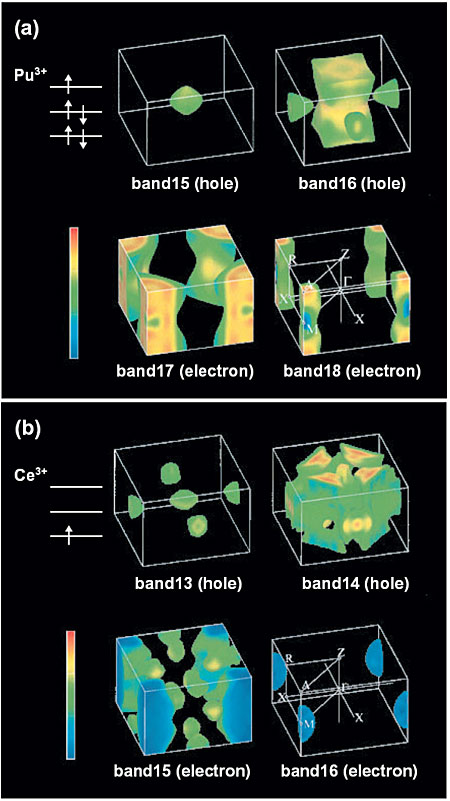7-3 | Unveiling the Electron States of a Pu-Based "High-Temperature" Superconductor |
 |
||
|
|
Recently, a superconducting compound containing Pu, PuCoGa5, has been discovered. The superconducting transition temperature Tc =18.5K is amazingly high. Since Tc for f-electron superconductors has been at most about 2K, this compound can be regarded as a "high-temperature" f-electron superconductor. Because of this discovery, it is necessary to reassess the previous conventional wisdom that Tc for f-electron superconductors is low.
PuCoGa5 belongs to the group of compounds with the HoCoGa5-type tetragonal crystal structure, which are frequently referred to as "115" systems. As a first step toward understanding high temperature superconductivity in PuCoGa5, we have analyzed the electronic structure of a series of 115 systems by means of a relativistic band calculation method. In Fig. 7-5(a) we show Fermi-surface sheets of PuCoGa5 obtained theoretically. Significant amounts of 5f electron character are found to exist on the Fermi surface, which characterizes the electronic properties of solids. In Fig. 7-5(b), we exhibit the Fermi-surface sheets of CeIrIn5, a typical superconducting material among Ce-115 systems. We note here that in spite of different numbers of f-electrons per ion, PuCoGa5 and CeIrIn5 have quite similar Fermi-surface structures with multi quasi-two-dimensional (Q2D) sheets. This point can be understood in terms of electron-hole symmetry, which means that the carriers determining the properties of a material behave as "electrons" or "holes." In Figs. 7-5(a) and (b), we show the electronic configurations of Ce3+ and Pu3+ ions, clearly indicating that apart from the difference in character, i.e., electron vs. hole, in both cases one carrier exists per ion. Thus, the Fermi-surface structures for these two compounds become quite similar. Why is PuCoGa5 a high temperature superconductor? If we assume the same magnetic mechanism as that in Ce-115, Tc should be scaled by the electronic energy. Since the itineracy of 5f electrons is greater than that of 4f electrons, Tc for 5f-electron systems is naturally higher than that of 4f-electron materials. Unfortunately, this argument cannot explain why U-115 and Np-115 are not superconducting. However, we note that superconductivity occurs in systems with multi Q2D Fermi-surface sheets. In non-superconducting U-115 and Np-115, the number of Q2D Fermi-surface sheets is unity or zero. The relation between the occurrence of superconductivity and the number of Q2D Fermi-surface sheets has not yet been clarified. However, considering the key issue of multi Q2D Fermi-surface sheets, we predict that superconductivity will occur in Pr-115, in which the foregoing Fermi-surface condition is satisfied. We look forward to progress in future experiments to test our prediction. |
|
Reference
T. Maehira et al., Electronic Structure and the Fermi Surface of PuCoGa5 and NpCoGa5, Phys. Rev. Lett., 90, 207007 (2003). |
| Select a topic in left column |
|
|
Persistent Quest Research Activities 2003
Copyright (C) Japan Atomic Energy Research Institute |